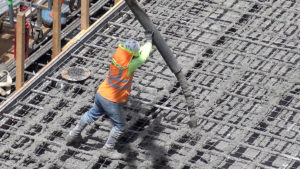

Leveraging carbon uptake to lower concrete’s carbon footprint


By: Andrew Paul Laurent, MIT Concrete Sustainability Hub
March 31, 2023 – To secure a more sustainable and resilient future, we must look carefully at the life cycle impacts of humanity’s most-produced building material: concrete. Carbon uptake, the process by which cement-based products sequester carbon dioxide, is key to this understanding.
Hessam AzariJafari, the MIT Concrete Sustainability Hub’s deputy director, is deeply invested in studying this process and its acceleration, where prudent. He describes how carbon uptake is key to reaching a carbon-neutral concrete industry.
First, What is carbon uptake in cement-based products, and how can it influence their properties?
Carbon uptake, or carbonation, is a natural process of permanently sequestering CO2 from the atmosphere by hardened cement-based products like concretes and mortars. Through this reaction, these products form different kinds of limes or calcium carbonates. This uptake occurs slowly but significantly during two phases of the life cycle of cement-based products: the use phase and the end-of-life phase.


In concrete reinforced with steel, the corrosion process can be initiated if the carbonation happens extensively (e.g., the whole of the concrete cover is carbonated) and intensively (e.g., a significant proportion of the hardened cement product is carbonated). Concrete cover is the layer distance between the surface of reinforcement and the outer surface of the concrete.
Next, What are the factors that influence carbon uptake?
The intensity of carbon uptake depends on four major factors: the climate, the types and properties of cement-based products used, the composition of binders (cement type) used, and the geometry and exposure condition of the structure.
In regard to climate, humidity and temperature affect the carbon uptake rate. The carbon uptake process is slowed in very low or very high humidity conditions. High temperatures speed up the process. The local atmosphere’s carbon dioxide concentration can affect the carbon uptake rate.
For example, carbon uptake is an order of magnitude in urban areas faster than in suburban areas.
The types and properties of cement-based products have a large influence on the rate of carbon uptake. For example, mortar (consisting of water, cement, and fine aggregates) carbonates two to four times faster than concrete (consisting of water, cement, and coarse and fine aggregates) because of its more porous structure.
Lastly, a structure’s surface area-to-volume ratio and exposure to air and water can have ramifications for its carbonation rate. When cement-based products are covered, carbonation may be slowed or stopped.
Concrete exposed to fresh air while sheltered from rain can have a larger carbon uptake compared to cement-based products that are painted or carpeted. Additionally, cement-based elements with large surface areas, like thin concrete structures or mortar layers, allow uptake to progress more extensively.
Lastly, What is the role of carbon uptake in the carbon neutrality of concrete?
How should architects and engineers account for it when designing for specific applications? Carbon uptake is a part of the life cycle of any cement-based products that should be accounted for in carbon footprint calculations.
Our evaluation shows the U.S. pavement network can sequester 5.8 million metric tons of CO2, of which 52 percent will be sequestered when the demolished concrete is stockpiled at its end of life.
The percentage of emissions sequestered from one concrete structure to another may vary. For instance, concrete bridges tend to have a lower percentage versus buildings constructed with concrete masonry. In any case, carbon uptake can influence concrete’s life cycle environmental performance.
“At the MIT Concrete Sustainability Hub, we have developed a calculator to enable construction stakeholders to estimate the carbon uptake of concrete structures during their use and end-of-life phases.”
Looking toward the future, carbon uptake’s role in the carbon neutralization of cement-based products could grow in importance.
While caution should be taken in regard to uptake when reinforcing steel is embedded in concrete, there are opportunities for different stakeholders to augment carbon uptake in different cement-based products.
Architects can influence the shape of concrete elements to increase the surface area-to-volume ratio (e.g., making “waffle” patterns on slabs and walls or having several thin towers instead of fewer large ones on an apartment complex). Concrete manufacturers can adjust the binder type and quantity while delivering concrete that meets performance requirements.
Finally, industrial ecologists and life-cycle assessment practitioners must work on the tools and add-ons to ensure carbon’s impact is well captured when assessing the potential impacts of cement-based products in buildings and infrastructure systems.
The cement and concrete industry is working with tech companies and local, state, and federal governments to lower and subsidize the carbon capture sequestration and neutralization code.
Accelerating carbon uptake where reasonable could be an additional lever to neutralize the carbon emissions of the concrete value chain.
“Carbon uptake is one more piece of the puzzle that makes concrete a sustainable choice for building in many applications. The sustainability and resilience of the future built environment lean on the use of concrete. There is still much work to be done to truly build sustainably, and understanding carbon uptake is an important place to begin.”
_____________________________
Reprinted with permission of MIT News” (http://news.mit.edu/). Follow the Pacific Northwest Building Resilience Coalition on LinkedIn here
Recent Posts
Mobilizing Resilient Design and Construction
Implementing a multifaceted strategy can motivate state and local governments to prioritize resilient design and…
Insurance Pricing: Navigating a New Era of Risk
The growing frequency and severity of climate-related disasters present a significant challenge for the insurance…
Designing for Resilience … It’s A Must
We see far too often structures built to current code that lack planning and design…
What are the Real Benefits of Designing for Resilience
While designing for resilience requires initial investments, the long-term payoffs often far outweigh these costs.…
Reducing Disaster Risks and Protecting Insurability in the Pacific Northwest
Proactive measures to enhance resilience and preparedness are critical to mitigating insurability risks. This will…
How to Achieve More Resilient Building Codes
More comprehensive disaster prevention perspectives are needed to enable communities better to withstand the increased…


